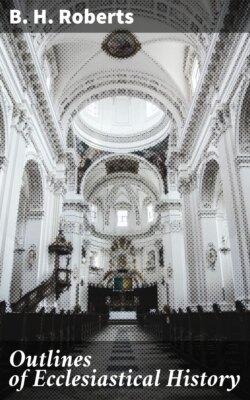Outlines of Ecclesiastical History

Реклама. ООО «ЛитРес», ИНН: 7719571260.
Оглавление
B. H. Roberts. Outlines of Ecclesiastical History
Outlines of Ecclesiastical History
Table of Contents
PART I. THE ESTABLISHMENT OF THE CHURCH
SECTION I
Section II.[11]
SECTION III
SECTION IV
SECTION V
SECTION VI
SECTION VII
SECTION VIII
Footnotes
PART II. THE APOSTASY
SECTION I
SECTION II
SECTION III
SECTION IV
SECTION V
SECTION VI
SECTION VII
SECTION VIII
Footnotes
PART III. THE REFORMATION
SECTION 1
SECTION II
SECTION III
SECTION IV
Footnotes
PART IV. THE RESTORATION OF THE GOSPEL
SECTION I
SECTION II
SECTION III
SECTION IV
SECTION V
SECTION VI
SECTION VII
SECTION VIII
SECTION IX
SECTION X
Footnotes
Index
Отрывок из книги
B. H. Roberts
Published by Good Press, 2019
.....
6. Mission and Character of the Roman Empire.—As the soil must be prepared before the wheat can be sown, so before the kingdom of heaven could throw up its shoots there was needed a kingdom of this world, where the nations were neither torn to pieces by violence nor were rushing after false ideals [as to governments] and spurious ambitions. Such a kingdom was the empire of the Caesars—a kingdom where peaceful men could work, think and speak as they pleased, and travel freely among provinces ruled for the most part by Gallios who protected life and property, and forbade fanatics to tear each other to pieces for their religious opinions. "It is not lawful for us to put a man to death," was the complaint of the Jewish priests to the Roman governor. Had Europe and Asia been covered with independent nations, each with a local religion represented in its ruling powers, Christianity must have been stifled in its cradle. If St. Paul had escaped the Sanhedrim of Jerusalem, he would have been torn to pieces by the silversmiths at Ephesus. The appeal to Caesar's judgment seat was the shield of his mission, and alone made possible his success.—Froude.
7. The Sanhedrin of the Jews.—"The council" of the Jewish church and people was a theocratic oligarchy, which after the return from the captivity (536 BC,) ruled the new settlement, being in all causes and over all persons, ecclesiastical and civil, supreme. It is supposed to be suggested by the old institution of seventy-two Elders (six from each tribe,) appointed by Moses, at Jethro's [Jeth-ro] suggestion, to relieve him in the administration of justice (Ex. xviii:14; Num. xi:16.) Having died out in the age succeeding Joshua, and being superceded under the monarchy, it was revived either by Ezra, or after the Macedonian ascendancy. It consisted of an equal number of priests, scribes and elders all of whom must be married, above thirty years of age, well instructed in the law, and of good report among the people. This constituted the Supreme Court of judicature and administrative council, taking cognizance of false doctrine and teaching, as well as breaches of the Mosaic Law, and regulating both civil and religious observances peculiar to the Jewish nation. The power of life and death had been taken from it by the Roman government which otherwise covenanted to respect its decrees. The council usually met in the hall Gazith, within the Temple precincts, though special meetings were sometimes held in the house of the high priest, who was generally (though not necessarily) the president. There were also two vice-presidents, and two scribes—clerks—or "heralds," one registering the votes of acquittal (or nos), and the other those of convictions (or ayes), and a body of lictors or attendants. The assembly set in the form of a semi-circle, the president occupying the center of the arc, the prisoner that of the center of the chord, while the two "heralds" sat a little in advance of the president, on his right and his left.—"Oxford Teacher's Bible"—Addenda.
.....